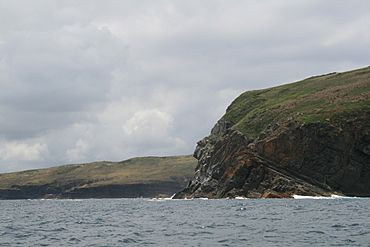Broughton Island (New South Wales) facts for kids
Quick facts for kids Broughton IslandNew South Wales |
|
|---|---|
 |
|
| Established | 1972 |
| Area | 1.14 km2 (0.4 sq mi) |
| Managing authorities | New South Wales National Parks & Wildlife Service |
| Website | Broughton Island |
Broughton Island is a special island located about 14 kilometers (about 9 miles) northeast of Port Stephens. It's on the Mid North Coast of New South Wales, Australia. This island is an important part of the Myall Lakes National Park. You can see it on a map here.
Contents
Island History
Archaeologists have found signs that the ancestors of the Worimi people lived on Broughton Island for at least 2,000 years. We don't know the name they had for the island. It was part of the land of the Garrawerrigal branch of the Worimi. "Garrawerrigal" meant "the people of the sea." They called a place on the island Niritba, which meant "the home of the mutton bird."
European Discovery
James Cook saw Broughton Island on May 11, 1770, while sailing on his ship, HM Bark Endeavour. He thought it was a headland and called it Black Head. Later, people realized it was an island. It was then renamed Broughton Islands. This name appeared on an 1852 map called Australia, East Coast.
The nearby area of Port Stephens was explored by Commander William Broughton in August 1795. He was on his ship, HMS Providence'. It seems the island and a bay nearby were named after Commander Broughton and his ship. This was likely suggested by Phillip Parker King, who lived in Port Stephens.
Rabbit Testing
Between 1905 and 1907, a French-Polish scientist named Jean Danysz used the island for a special test. He was trying to find a way to control wild rabbits in Australia.
Broughton Island National Park
Broughton Island became part of the Myall Lakes National Park in 1972. This means it's a protected area. Many interesting animals live here.
Island Wildlife
Wedge-tailed shearwaters, also known as "muttonbirds," make their nests on the island. You can also find Australian little penguins here. This island is one of the most northern places where these penguins live. In November 2009, the National Parks and Wildlife Service announced good news. They had successfully removed all rabbits and rats from the island. This helps protect the native wildlife.


